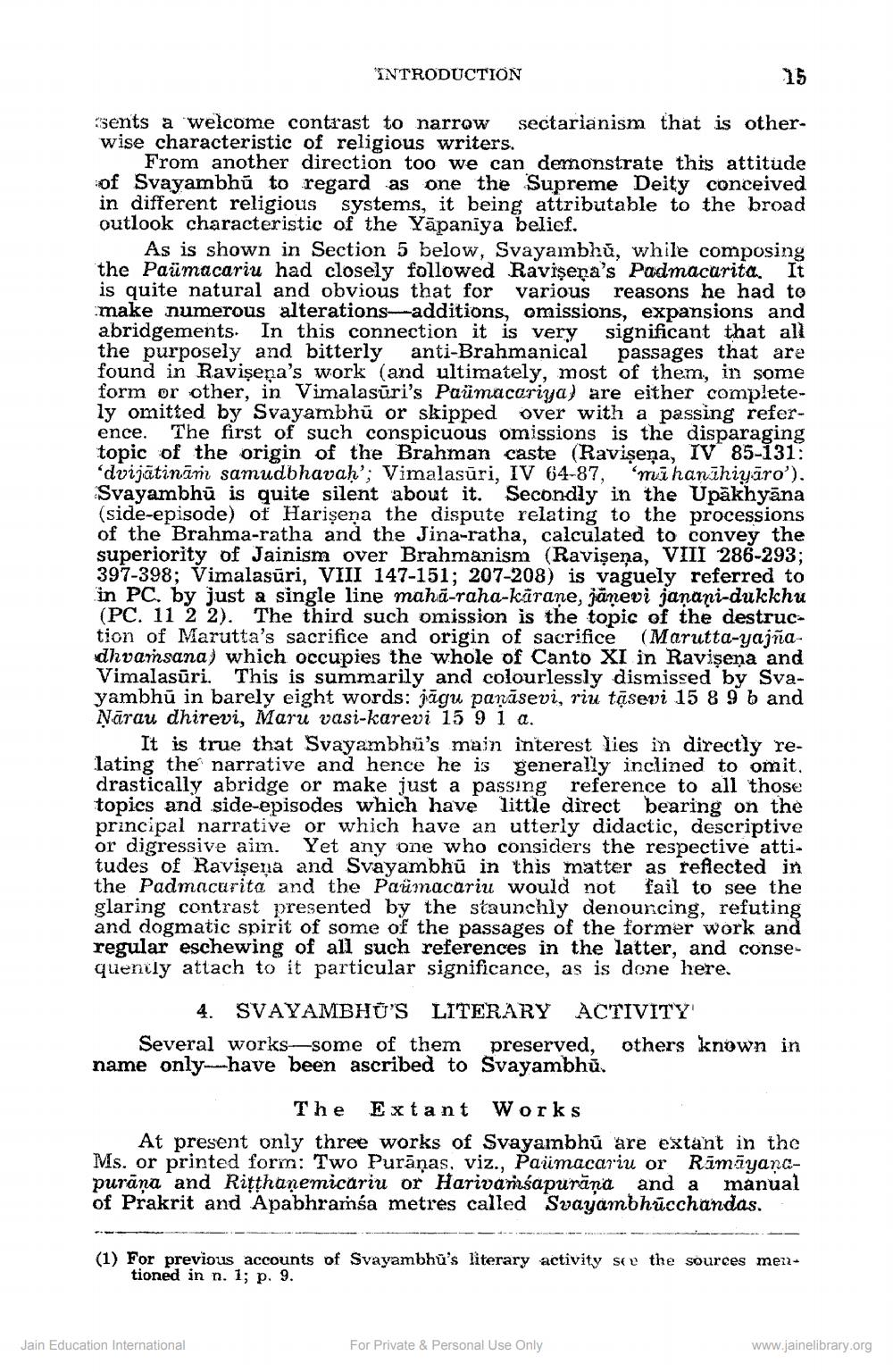________________
'INTRODUCTION
15
sents a welcome contrast to narrow sectarianism that is otherwise characteristic of religious writers.
From another direction too we can demonstrate this attitude of Svayambhū to regard as one the Supreme Deity conceived in different religious systems, it being attributable to the broad outlook characteristic of the Yāpaniya belief.
As is shown in Section 5 below, Svayambhů, while composing the Paümacariu had closely followed Ravişena's Padmacarita. It is quite natural and obvious that for various reasons he had to make numerous alterations additions, omissions, expansions and abridgements. In this connection it is very significant that all the purposely and bitterly anti-Brahmanical passages that are found in Ravişena's work (and ultimately, most of them, in some form or other, in Vimalasūri's Paümaçariya) are either completely omitted by Svayambhū or skipped over with a passing reference. The first of such conspicuous omissions is the disparaging topic of the origin of the Brahman caste (Ravisena, IV 85-131: dvijatinan samudbhavaḥ'; Vimalasūri, IV 64-87, 'mahanihiyāro'). Svayambhū is quite silent about it. Secondly in the Upākhyāna (side-episode) of Harişena the dispute relating to the processions of the Brahma-ratha and the Jina-ratha, calculated to convey the superiority of Jainism over Brahmanism (Ravişena, VIII 286-293; 397-398; Vimalasūri, VIII 147-151; 207-208) is vaguely referred to in PC. by just a single line mahā-raha-kärane, jänevi janani-dukkhu (PC. 11 2 2). The third such omission is the topic of the destruction of Marutta's sacrifice and origin of sacrifice (Marutta-yajñadhvamsana) which occupies the whole of Canto XI in Ravişena and Vimalasūri. This is summarily and colourlessly dismissed by Svayambhū in barely eight words: jigu panāsevi, riu tasevi 15 8 9 b and Ņārau dhirevi, Maru vasi-karevi 15 9 1 a.
It is true that Svayambhu's main interest lies in directly relating the narrative and hence he is generally inclined to omit, drastically abridge or make just a passing reference to all those topics and side-episodes which have little direct bearing on the principal narrative or which have an utterly didactic, descriptive or digressive aim. Yet any one who considers the respective attitudes of Ravişena and Svayambhū in this matter as reflected in the Padmacarita and the Paümacariu would not fail to see the glaring contrast presented by the staunchly denouncing, refuting and dogmatic spirit of some of the passages of the former work and regular eschewing of all such references in the latter, and consequently attach to it particular significance, as is done here.
Vimalasura, which occupies and originon is the compete janani-dukkehtinen
4. SVAYAMBHU'S LITERARY ACTIVITY Several works—some of them preserved, others known in name only have been ascribed to Svayambhū.
The Extant Works At present only three works of Svayambhú are extant in the Ms. or printed form: Two Purāņas, viz., Paimacariu or Rāmāyangpurāna and Ritthanemicariu or Harivarśapurāna and a manual of Prakrit and Apabhramsa metres called Svayambhūcchandas.
(1) For previous accounts of Svayambhu's literary activity see the sources men.
tioned in n. 1; p. 9.
Jain Education International
For Private & Personal Use Only
www.jainelibrary.org




